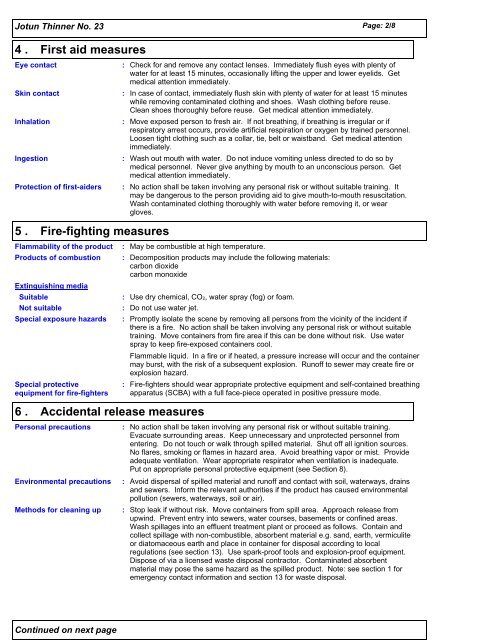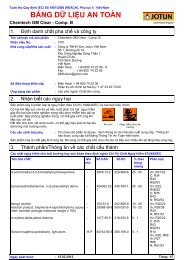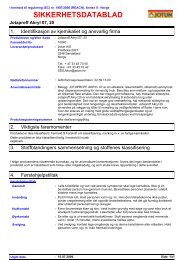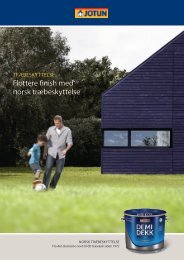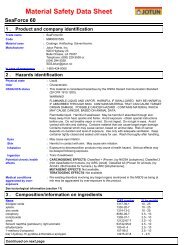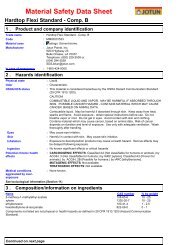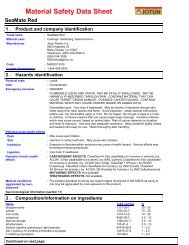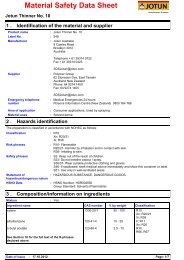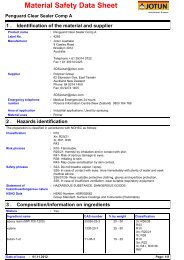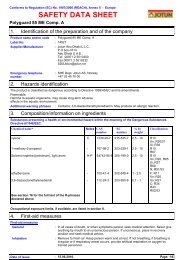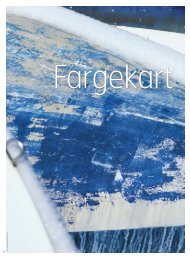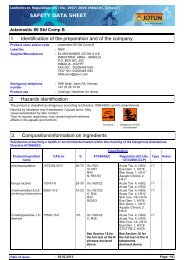Jotun Thinner No. 23 - Marine_Protective - English (us) - Canada
Jotun Thinner No. 23 - Marine_Protective - English (us) - Canada
Jotun Thinner No. 23 - Marine_Protective - English (us) - Canada
You also want an ePaper? Increase the reach of your titles
YUMPU automatically turns print PDFs into web optimized ePapers that Google loves.
<strong>Jotun</strong> <strong>Thinner</strong> <strong>No</strong>. <strong>23</strong> Page: 2/84 .First aid measuresEye contactSkin contactInhalationIngestionProtection of first-aiders::::Check for and remove any contact lenses. Immediately fl<strong>us</strong>h eyes with plenty ofwater for at least 15 minutes, occasionally lifting the upper and lower eyelids. Getmedical attention immediately.In case of contact, immediately fl<strong>us</strong>h skin with plenty of water for at least 15 minuteswhile removing contaminated clothing and shoes. Wash clothing before re<strong>us</strong>e.Clean shoes thoroughly before re<strong>us</strong>e. Get medical attention immediately.Move exposed person to fresh air. If not breathing, if breathing is irregular or ifrespiratory arrest occurs, provide artificial respiration or oxygen by trained personnel.Loosen tight clothing such as a collar, tie, belt or waistband. Get medical attentionimmediately.Wash out mouth with water. Do not induce vomiting unless directed to do so bymedical personnel. Never give anything by mouth to an unconscio<strong>us</strong> person. Getmedical attention immediately.: <strong>No</strong> action shall be taken involving any personal risk or without suitable training. Itmay be dangero<strong>us</strong> to the person providing aid to give mouth-to-mouth res<strong>us</strong>citation.Wash contaminated clothing thoroughly with water before removing it, or weargloves.5 .Fire-fighting measuresFlammability of the productProducts of comb<strong>us</strong>tionExtinguishing mediaSpecial protectiveequipment for fire-fighters::Suitable :<strong>No</strong>t suitable :Special exposure hazards ::May be comb<strong>us</strong>tible at high temperature.Decomposition products may include the following materials:carbon dioxidecarbon monoxideUse dry chemical, CO2, water spray (fog) or foam.Do not <strong>us</strong>e water jet.Promptly isolate the scene by removing all persons from the vicinity of the incident ifthere is a fire. <strong>No</strong> action shall be taken involving any personal risk or without suitabletraining. Move containers from fire area if this can be done without risk. Use waterspray to keep fire-exposed containers cool.Flammable liquid. In a fire or if heated, a pressure increase will occur and the containermay burst, with the risk of a subsequent explosion. Runoff to sewer may create fire orexplosion hazard.Fire-fighters should wear appropriate protective equipment and self-contained breathingapparat<strong>us</strong> (SCBA) with a full face-piece operated in positive pressure mode.6 .Accidental release measuresPersonal precautions :Environmental precautionsMethods for cleaning up :<strong>No</strong> action shall be taken involving any personal risk or without suitable training.Evacuate surrounding areas. Keep unnecessary and unprotected personnel fromentering. Do not touch or walk through spilled material. Shut off all ignition sources.<strong>No</strong> flares, smoking or flames in hazard area. Avoid breathing vapor or mist. Provideadequate ventilation. Wear appropriate respirator when ventilation is inadequate.Put on appropriate personal protective equipment (see Section 8).: Avoid dispersal of spilled material and runoff and contact with soil, waterways, drainsand sewers. Inform the relevant authorities if the product has ca<strong>us</strong>ed environmentalpollution (sewers, waterways, soil or air).Stop leak if without risk. Move containers from spill area. Approach release fromupwind. Prevent entry into sewers, water courses, basements or confined areas.Wash spillages into an effluent treatment plant or proceed as follows. Contain andcollect spillage with non-comb<strong>us</strong>tible, absorbent material e.g. sand, earth, vermiculiteor diatomaceo<strong>us</strong> earth and place in container for disposal according to localregulations (see section 13). Use spark-proof tools and explosion-proof equipment.Dispose of via a licensed waste disposal contractor. Contaminated absorbentmaterial may pose the same hazard as the spilled product. <strong>No</strong>te: see section 1 foremergency contact information and section 13 for waste disposal.Continued on next page


